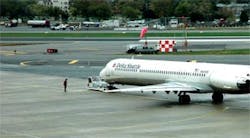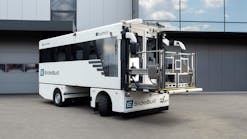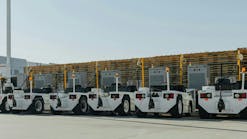Show Us the Green... And We Will Show You the Money
The New York Power Authority (NYPA) is the largest and completely state-owned power organization in the nation. With 18 operating plants, NYPA provides nearly 22 percent of the lowest-cost, predominantly hydro-powered electricity in New York State. Following its mission to provide clean, economical and reliable energy while promoting energy efficiency and innovation for the benefit of its customers, NYPA not only provides electricity to New York City government entities such as hospitals, schools, libraries and transit, but has also been working closely with New York airports for the past seven years.
“Though we have a relationship with the airlines, it is one step removed,” explains John Markowitz, electric transportation engineer, New York Power Authority. “We supply power to some of the airports (Westchester County, La Guardia and JFK) and our mandate, being a public entity, is to help the environment and reduce the use of imported fuels.”
In the Beginning
NYPA is one of the leading experts in the US to demonstrate the advantage of implementing electric drive technologies, according to Brian Warner, director of policy analysis and external communications for NYPA. “The Power Authority is cognizant and we are promoters of demonstrating the need to shift the transportation sector to electric drive technologies,” Warner says. “We view our penetration into the airport support vehicle market as a portion of our overall mission to protect the environment and we have demonstrated through a variety of our projects that electric drive technology works best and is the easiest transition for support vehicles.”
NYPA supplies power to both JFK and LaGuardia airports and in 2001 was in the process of working on a proposal for a federal grant with Delta and American Airlines in cooperation with the airports. The Power Authority teamed with one of its electric customers, the Port Authority of New York and New Jersey, to apply for a Federal Aviation Authority grant under what was then known as ILEAV (Inherently Low Emission Airport Vehicle).
“[American Airlines and Delta Airlines] were going to electrify most of their fleet of bag tugs and belt loaders at those two airports and it was a very large project,” Markowitz, says. “Of course then Sept. 11 came, the project was tabled, and the airlines struggled at that point just to keep surviving.”
New Answers, Same Obstacles
Though the project remained dormant until 2003, at which time discussions with the Power Authority and the airlines were resurrected, interim research revealed to Markowitz the tremendous role that ground support equipment could play in terms of meeting NYPA’s clean air goals.
Research found that one tug emits 54 tons of greenhouse gases and expends 3,248 gallons of diesel per year. “Because of the old engines, operating a diesel-powered tug is about the same as driving 46 standard vehicles on the road,” Markowitz says. “And the fact that the GSE technology has reached maturity, made airport ground support vehicles an attractive target for us.”
According to Markowitz, even when taking into account the power plant emissions fueling the vehicles; on average, using electricity makes a vehicle 90 percent cleaner and 75 percent less expensive to operate.
“We tried to get the FAA grants rolling once again — with either LaGuardia, JFK or Delta and American,” Markowitz says, “but due to the financial status of the airlines at the time and complications trying to get contracts to work with the FAA, we ended up paring the project down to one airline — Delta, with a focus on just the Marine Air Terminal at LaGuardia.”
A No-Brainer
Depending on the project, NYPA and its Clean Transportation Group provide gap funding or help the customer with identifying available funding and also provide the expertise to install and check the necessary equipment. In 2006, NYPA assisted Delta Air Lines in the replacement of its fleet of 15 diesel-operated GSE with electric models (seven baggage tractors, six belt loaders and two aircraft tractors) at the historic Marine Air Terminal, co-funded the cost of high-tech rapid chargers and introduced Delta to QCAP (Queens Clean Air Project) who provided them with additional funding. “Another interesting point about this project,” Markowitz says, “we replaced two aircraft tugs with the electric towbarless TLD which at the time were the first of their type in the country … compared to the old diesel units with the towbar … it was a big upgrade for the operators.” This was NYPA’s first airport and the entire project was completed in 2006.
Since then, they have been working with the Albany County Airport Authority and Delta Air Lines where they just completed a similar project, and are now in the early phases with Westchester County Airport.
“Westchester is a unique case because all of the GSE is actually owned by the airport,” Markowitz explains. “Though the project is pending, we helped the county apply for a federal grant and we are looking at 20 to 25 vehicles which will end up going for bid.”
NYPA is also working with the Stewart International Airport, where they are implementing gate electrification.
A Clean Future
Timing is everything. Unfortunately, the ILEAV program was stopped dead in its tracks after the events of 9/11. The resulting economic downturn in the airline industry had direct consequences on ILEAV commitments. In many cases, airlines and other organizations scaled back their planned acquisitions of GSE using alternative fuels. The projects most affected, according to the FAA, were in Atlanta (ATL), Chicago (ORD), and New York (JFK and LGA).
The sponsors of these airports made repeated good-faith efforts to restructure their projects and to attract new participants, but in the end had to ask the FAA to terminate their ILEAV grants and to redistribute the funding to other eligible Airport Improvement Projects (AIP). However, the FAA relied on the ILEAV experience to design the national Voluntary Airport Low Emission Program (VALE), which was authorized in the Vision 100 Century of Aviation Reauthorization Act of 2003.
Currently, only 10 airports and nine airlines have been part of the ILEAV and VALE projects since 2001, yet there are 514 airports eligible for the VALE program. Perhaps this is soon to change. “Green” seems to be quickly becoming the wave of the environmental future across all industries so it may not be long before these programs begin to grow, exponentially.
Southern California Edison (SCE) has been involved in airport and GSE electrification projects for more than 10 years. In a paper titled California Airports’ Ground Support Equipment and the Memorandum of Understanding, Coleen Tessema, electric transportation project manager sums it up, “The airlines achieve emission goals; airport management and airlines realize operational savings through reduced maintenance and off-peak charging; GSE operators enjoy a reduced noise level and a less congested work environment; the surrounding communities breathe cleaner air’ the utility mitigates any adverse system impact on the distribution system; and all stakeholders gain positive brand equity.”
As Roger B. Kelley, president and chief executive officer of the New York Power Authority remarks, “Two of our nation’s biggest challenges are to cut our dependence on foreign oil and to fight the threat of global warming. With these vehicles that are out on the tarmac, we’re taking on both.”
To learn more about the VALE program go to: http://www.faa.gov/airports_airtraffic/airports/environment/vale/





